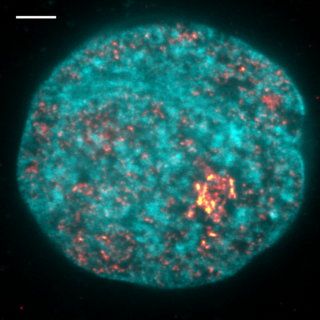Putting genetic material into pockets

International team of researchers discovers how the nucleus structures active and inactive DNA.
An international team of researchers from FAU, the Max Planck Institute of Molecular Cell Biology and Genetics (MPI-CBG), the Max Planck Institute for the Physics of Complex Systems (MPI-PKS), the Center for Systems Biology Dresden (CSBD) and the Tokyo Institute of Technology in Japan, has now discovered how the genetic material organises itself into active and inactive ‘pockets’ within the nucleus, how these pockets are created for transcription and how this pattern can be explained using a physical model.
In eukaryotes, the genetic material stored in DNA is located inside the cell nuclei. During a process called transcription, which also occurs in the nucleus, parts of the DNA are copied and rewritten in RNA or a transcript that contains the information required for protein synthesis. Transcription is a fundamental cellular process of gene expression and is subject to precise controls so that functional products are produced in the right place at the right time to ensure cells function and the organism develops properly. It has been known for some time that defined areas exist within the cell nucleus that contain transcriptionally active and inactive DNA. However, it remained unclear how the genetic material, the DNA, is sorted into active and inactive areas and how these areas are created.
An international team of researchers from FAU, MPI-CBG, MPI-PKS, CSBD and the Tokyo Institute of Technology in Japan have investigated this unsolved mystery and published their results in the journal Nature Communications. They chose an interdisciplinary approach and combined the latest super high-resolution microscopy techniques with theoretical models. This enabled the researchers to look deep into the nuclei of zebra fish and observe the DNA and RNA transcripts in time and space during the transcription process. They observed that the DNA, which is initially evenly distributed in the nucleus, forms a finely-structured pattern in the nucleus as soon as the RNA transcripts appear.
Lead investigator Nadine Vastenhouw explains, ‘When the cell changed from a state without transcription to an active state, we clearly observed areas with a high density of DNA. We also saw that there were pockets with hardly any DNA which were filled instead with RNA during the transcription process. This pattern shows that the RNA formed by transcription can organise the DNA into an ‘active’ pocket, which the inactive DNA is pushed out of.’
However, the transcription process simultaneously prevents these pockets from being completely separate. FAU researcher Vasily Zaburdaev who works at the Max Planck Centre for Physics and Medicine and was also involved in the study adds, ‘To us, it seemed as if the DNA and RNA were trying to avoid each other, in the same way that water and oil don’t mix. Both phases are connected by the active DNA. Just like soap, where adding a mixture of oil and water leads to small bubbles forming, in other words an emulsion.’
Lead author Lennart Hilbert was a postdoc in Nadine Vastenhouw (MPI-CBG) and Vasily Zaburdaev’s group (MPI-PKS at the time) and is now researching at the Karlsruhe Institute of Technology (KIT). He explains, ‘In our work, we were able to explain the separation of active and inactive genes, which has been known about in cell biology for several decades, using the language of theoretical physics. The research environment in the institutes in Dresden, which is geared towards collaboration, was a decisive factor as it enabled us to combine extremely advanced microscopy techniques in zebra fish embryos with biophysical model simulations.’
Nadine Vastenhow, who now works at the University of Lausanne in Switzerland, gives an indication of the significance of the study, ‘Transcription is a fundamental biological process. To ensure that our genome is processed properly and that the correct end products are created, the genome and the ‘machinery’ required for each step must be very well organised in the nucleus. Our study is an important step towards understanding how DNA and transcription activity are organised to ensure that the correct products are produced, and that cells develop properly and form tissue together to enable the organism to develop normally.’
Further information
DOI: s41467-021-21589-3
Prof. Vasily Zaburdaev